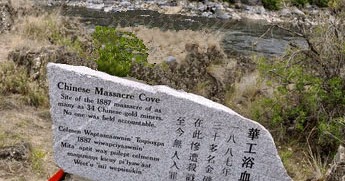5fish
Well-Known Member
- Joined
- Jul 28, 2019
- Messages
- 10,739
- Reaction score
- 4,570
The first great massacres of Chinese as in Los Angeles in 1871... The link describes the events in detail...

 www.laweekly.com
www.laweekly.com
The greatest unsolved murders in Los Angeles' history — bloodier than the Black Dahlia, more coldly vicious than the hit on Bugsy Siegel — occurred on a cool fall night in 1871. Seventeen Chinese men and boys, including a popular doctor, were hanged by an angry mob near what is now Union Station, an act so savage that it bumped the Great Chicago Fire off the front page of The New York Times.
snip...
Eight men eventually were convicted, but the verdicts were thrown out almost immediately for a bizarre technical oversight by the prosecution. Unbelievably for a crime that occurred in full view of hundreds of people, no one was ever again prosecuted.
Here at this link is a 8min video of the event...

 www.kcet.org
www.kcet.org
Here is wiki link to the event...
Chinese massacre of 1871 - Wikipedia
snip... photos...
The Chinese massacre of 1871 was a racial massacre that occurred on October 24, 1871, in Los Angeles, California, when a mob of around 500 White and Hispanic persons entered Old Chinatown and attacked, bullied, robbed, and murdered Chinese residents in cold blood.[1][2] The massacre took place on Calle de los Negros also referred to as "Negro Alley". The mob gathered after hearing the policeman and rancher were killed as a result of a conflict between rival tongs, the Nin Yung, and Hong Chow. When news of their death had passed through the city, along with the rumors that the Chinese community "were killing whites wholesale", more men gathered around the boundaries of Negro Alley. A few 21st-century sources have described this as the largest mass lynching in American history.[2][3]
An estimated 17 to 20 Chinese immigrants were killed and later hanged by the mob in the course of the riot, but most had already been shot to death. At least one was mutilated, when someone cut off a finger to get his diamond ring. Ten men of the mob were prosecuted and eight were convicted of manslaughter in these deaths. The convictions were overturned on appeal due to technicalities.

How Los Angeles Covered Up the Massacre of 17 Chinese - LA Weekly
The greatest unsolved murders in Los Angeles' history — bloodier than the Black Dahlia, more coldly vicious than the hit on Bugsy Siegel — occurred on a cool fall night in 1871. Seventeen Chinese men and boys, including a popular doctor, were hanged by an angry mob near what is...
 www.laweekly.com
www.laweekly.com
The greatest unsolved murders in Los Angeles' history — bloodier than the Black Dahlia, more coldly vicious than the hit on Bugsy Siegel — occurred on a cool fall night in 1871. Seventeen Chinese men and boys, including a popular doctor, were hanged by an angry mob near what is now Union Station, an act so savage that it bumped the Great Chicago Fire off the front page of The New York Times.
snip...
Eight men eventually were convicted, but the verdicts were thrown out almost immediately for a bizarre technical oversight by the prosecution. Unbelievably for a crime that occurred in full view of hundreds of people, no one was ever again prosecuted.
Here at this link is a 8min video of the event...

The Chinese Massacre: One of Los Angeles' Worst Atrocities
On October 24, 1871, a mob of Anglos and Latinos murdered nearly 20 Chinese immigrants.
Here is wiki link to the event...
Chinese massacre of 1871 - Wikipedia
snip... photos...
The Chinese massacre of 1871 was a racial massacre that occurred on October 24, 1871, in Los Angeles, California, when a mob of around 500 White and Hispanic persons entered Old Chinatown and attacked, bullied, robbed, and murdered Chinese residents in cold blood.[1][2] The massacre took place on Calle de los Negros also referred to as "Negro Alley". The mob gathered after hearing the policeman and rancher were killed as a result of a conflict between rival tongs, the Nin Yung, and Hong Chow. When news of their death had passed through the city, along with the rumors that the Chinese community "were killing whites wholesale", more men gathered around the boundaries of Negro Alley. A few 21st-century sources have described this as the largest mass lynching in American history.[2][3]
An estimated 17 to 20 Chinese immigrants were killed and later hanged by the mob in the course of the riot, but most had already been shot to death. At least one was mutilated, when someone cut off a finger to get his diamond ring. Ten men of the mob were prosecuted and eight were convicted of manslaughter in these deaths. The convictions were overturned on appeal due to technicalities.








